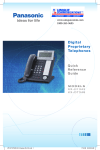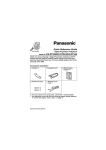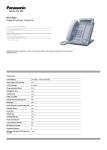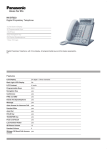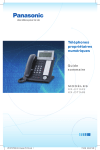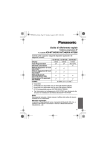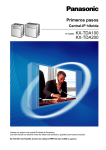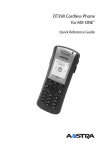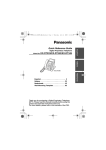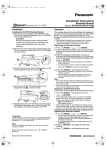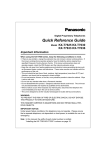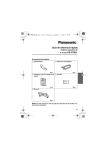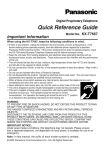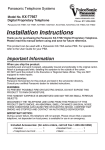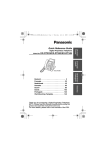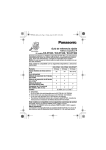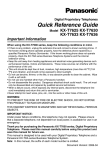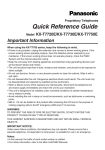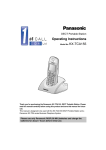Download Quick Reference Guide - Constant Contact Communications
Transcript
Quick Reference Guide <KX-DT346> Digital Proprietary Telephone Model No. KX-DT333/KX-DT343/KX-DT346 Thank you for purchasing a Digital Proprietary Telephone (DPT). Please read this manual carefully before using this product and save this manual for future use. For more details, please refer to the manuals of the PBX. Accessories (included) *1 Handset: 1 Handset Cord: 1 Screws for wall: 2 Telephone Line Cord*2: 1 Wall Mounting Adaptor*1: 1 This telephone comes with the wall mounting adaptor already attached. To remove the adaptor, refer to step 1 on page 17. *2 Plug shapes vary between countries or areas. This unit supports the following optional devices and features: KX-DT333 KX-DT343 KX-DT346 Features Display 3-Line 3-Line 6-Line Flexible Buttons 24 24 24 LCD Backlight Q Q Options KX-NT303 Add-on 12 Key Module Q Q KX-NT307 (PSLP1528) Bluetooth® Module*1 *2 *3 KX-DT301 USB Module*3 KX-DT390 DSS Console (with 60 keys)*2 Q Q Q Q Q Q Q Q: Available *1 The availability of the Bluetooth Module depends on the software version of the connected PBX. Consult your dealer for more details. *2 For information on connecting, refer to the each included manual. *3 When connecting DPTs via Digital XDP, this optional device cannot be used. Trademark: The Bluetooth® word mark and logos are owned by the Bluetooth SIG, Inc. and any use of such marks by Panasonic Corporation is under licence. 2 Location of Controls Location of Controls V U A T B C D E F S G H I J R Q K L M N O P <KX-DT346> A LCD (Liquid Crystal Display) B PAUSE: Used to insert a pause when storing a telephone number. This button is also used for programming this unit. C FWD/DND (Call Forwarding/ Do Not Disturb): Used to set Call Forwarding or Do Not Disturb on your extension. D CONF (Conference): Used to establish a multiple party conversation. E INTERCOM: Used to make or receive intercom calls. F AUTO ANS (Auto Answer)/ MUTE: Used to receive an incoming call in hands-free mode or mute the microphone/handset during a conversation. G AUTO DIAL/STORE: Used for System/Personal Speed Dialling or storing programme changes. 3 Location of Controls H TRANSFER: Used to transfer a call to another party. I REDIAL: Used to redial the last dialled number. J MESSAGE: Used to leave a message waiting indication or call back the party who left the message waiting indication. K Headset Jack L FLASH/RECALL: Used to disconnect the current call and make another call without hanging up. M HOLD: Used to place a call on hold. N SP-PHONE (Speakerphone): Used for performing hands-free operations. O ENTER: Used to assign the selected item. P Microphone: Used for hands-free conversations. 4 Q Navigator Key: Used to adjust the volume and the display contrast or select desired items. R CANCEL: Used to cancel the selected item. S Flexible Buttons: Used to seize an outside line or perform a feature that has been assigned to the key. T LCD Panel: Can be adjusted to the desired angle. U Soft Buttons (S1-S4): S1-S4 (located from left to right) are used to select the item displayed on the bottom line of the display. V Message/Ringer Lamp: When you receive an intercom call, the lamp flashes green, and on an outside call, the lamp flashes red. When someone has left you a message, the lamp stays on red. Settings Settings Speaker volume While in a hands-free conversation Handset/Headset While using the handset or headset volume*1 Ringer volume While on-hook or receiving a call LCD Contrast While on-hook Press Up to increase or Down to decrease the volume. PAUSE PAUSE Ring Tone PAUSE LCD Backlight*2 (CO) PAUSE OR INTERCOM OR AUTO DIAL Press 2 times. STORE While on-hook Automatic PAUSE OR AUTO DIAL Always ON Always OFF STORE PAUSE OR AUTO DIAL STORE *1 If you hear your own voice through the handset or headset, decrease the volume. *2 For KX-DT343/KX-DT346 only. 5 Features List Features List Icon Meanings (CO) = Flexible button = Off-hook = Feature number = Talk = On-hook C. Tone = Confirmation Tone Making Calls Calling To an extension To an outside party extension no. (CO) outside phone no. Redial REDIAL Quick Dialling quick dialling no. One-touch Dialling To store AUTO DIAL PAUSE (CO) desired no.* (max. 32 digits) PAUSE STORE * Enter outside line access number before outside phone number. To dial assigned as a (One-touch Dialling) One-touch Dialling button Personal Speed Dialling To store desired phone no.* personal speed (max. 32 digits) dialling no. (2 digits) C. Tone * Enter outside line access number before outside phone number. To dial AUTO DIAL STORE 6 personal speed dialling no. (2 digits) Features List System Speed Dialling To dial AUTO DIAL system speed dialling no. (3 digits) STORE Doorphone Call doorphone no. (2 digits) C. Tone During a Conversation Call Hold To hold To retrieve a call at the holding extension HOLD (CO) C. Tone / INTERCOM To retrieve an outside call from another extension (CO) Call Transfer extension no. TRANSFER C. Tone (CO) To an extension outside phone no. To an outside party Useful Features Multiple Party Conversation To add other parties during a conversation (i.e., conference) CONF C. Tone desired phone no. CONF Talk to the new party. C. Tone Talk with multiple parties. To leave a conference CONF C. Tone 7 Features List Setting the Telephone According to Your Needs Do Not Disturb Both Calls Set Outside Calls Cancel C. Tone Intercom Calls Timed Reminder To set 12 H hour/minute (4 digits) 24 H hour/minute (4 digits) AM PM Once Daily C. Tone To cancel To stop or answer the ring back INTERCOM / C. Tone Before Leaving Your Desk Call Forwarding Both Calls Outside Calls Intercom Calls All calls extension no. Busy No answer Busy/ No answer Cancel 8 OR outside line access no. outside phone no. C. Tone Features List Making Use of the Voice Mail Service Listening to a message From your own extension KX-TVM series Listen to Message VPS extension no. Deliver Message Mailbox Password* Mailbox Management * If you have no password, you can skip the last step. Automated Attendant Note: VPS = Voice Processing System Message Notification Other Features From someone else’s extension End Call VPS extension no. KX-TVP series Listen to Message mailbox no. Deliver Message Mailbox Password* Check Mailbox Distribution Automated Attendant * If you have no password, you can skip the last step. Mailbox Management Other Features End Call Leaving a message VPS extension no. From your own extension Mailbox Password* From someone else’s extension mailbox no. Mailbox Password* * If you have no password, you can skip the last step. Enter the desired mailbox number Leave a message To send the message immediately (KX-TVM series) (KX-TVP series) Follow the guidance To set the delivery time 9 Features List During playback Repeat Voice Guidance Exit • Consult your dealer for more details regarding feature numbers. • It is possible to assign flexible buttons as feature buttons. • Control panel/button names and descriptions can be found in "Location of Controls" on page 3. Accessing Features Using the Display Using the LCD Display It is possible to access the following directories, logs, and menus by pressing left or right on the Navigator Key while this unit is idle: Incoming Call Log Outgoing Call Log Personal Speed Dialling Directory System Speed Dialling Directory Extension Number Directory Feature Access Entering Characters You can enter alphabetic characters and digits using the dialling buttons. Pressing a dialling button repeatedly displays different characters, as shown in the following tables. While entering characters, you can move the cursor with the left and right Navigator keys and delete characters with the TRANSFER button. To toggle between Table 1 and Table 2, press the Soft button (S1) at any time while entering characters. For a list of available characters, refer to the next page. 10 Acessing Features Using the Display Acessing Features Using the Display Table 1 (Standard mode) Times Buttons ! ? " 1 A B C a b c 2 D E F d e f 3 G H I g h i 4 J K L j k l 5 M N O m n o 6 P Q R S p q r T U V t u v 8 W X Y Z w x y (space) . , ’ : ; 0 / + — = < > $ % & @ ( ) s 7 z 9 £ # Table 2 (Option mode) Times Buttons 10 11 12 13 14 15 ! ? " ä ö ü 1 A B C a b c À Á Â Ã Ä Å D E F d e f Ð È É Ê Ë 3 G H I g h i Ì Í Î Ï 4 J K L j k l 5 M N O m n o Ñ Ò Ó Ô Õ P Q R S p q r s Š ß 7 T U V t u v Ù Ú Û Ü 8 W X Y Z w x y z ý Z 9 ’ : ; 0 £ # (space) . , / + — = < > $ % & @ ( ) Ö Æ Ç 2 Ø Œ 6 11 Operation Board Angle Adjustment Operation Board Angle Adjustment The angle of the operation board can be set to one of eight angles (level 1 = 0°, level 8 = 45°). 8 76 5 4 3 2 1 CAUTION: Hold the operation board until the operation board is secured at the desired angle. Make sure you do not pinch your fingers when raising or lowering the operation board. To raise: Gently lift the operation board one level at a time. To lower: Raise the operation board to level 8. Next, with one hand on the base of the unit, lift the operation board again to release the latch, then slowly push the operation board down to level 1. If the operation board cannot be lowered to level 1, repeat this step. Locking the Handset Hook Pull down the handset hook until it locks to prevent the handset from falling off the handset cradle when the unit is mounted to a wall or set at a high angle. To temporarily place the handset down during a conversation, hook it over the top edge of the unit as shown. 12 Connection Connection <Back view> Connect to: a digital proprietary telephone — Digital XDP connection a single line telephone — XDP or parallel connection The telephone line cord (included) Connect to a PBX. Clamp Headset Do not use a KX-T7090 headset. Recommended for use in Australia and New Zealand: KX-TCA89 • Consult your dealer for more details about XDP and Digital XDP. CAUTION: When connecting a headset • Ensure that the headset cord is wound around the hook to prevent damage to the connector. When connecting cords • Ensure the cords are inserted in the grooves, and are clamped to prevent damage to the connectors. 13 Installing KX-DT301/KX-NT303 Installing KX-DT301/KX-NT303 CAUTION: • To prevent damage to the telephone, be sure to unplug the extension line before you set up or remove the KX-DT301 (USB Module) or the KX-NT303 (Add-on 12 Key Module). • Connect the KX-NT303 first when installing both the KX-DT301 and the KX-NT303. KX-NT303 The Add-on 12 Key Module allows 12 additional flexible buttons to be added to this unit. These buttons are used to seize an outside line, make a call using One-touch Dialling, or perform a feature that has been assigned to the key. <with a KX-DT346> 1. Open the cover. 2. Attach the KX-NT303 to your unit with the screws (included with KX-NT303). 3. Plug the flat cable into the connector (A), then bend the cable slightly as shown (B). 14 4. Close the cover. Installing KX-DT301/KX-NT303 KX-DT301 The USB Module can be connected between the DPT and the personal computer through USB interface to implement personal CTI (Computer Telephony Integration). 1. Open the cover. 2. Plug the flat cable into the connector as shown. 3. Close the cover. 4. Connect the USB cable to the USB port. Connect to a PC • Ensure that the USB cable goes through the cable guide. • Please use a USB cable shorter than 3 m. 15 Installing KX-DT301/KX-NT303 5. Insert the protrusions on the KX-DT301 into the 2 holes in the unit. 7. Install the USB driver. Refer to Installation Manual on the CD-ROM included with KXDT301. 16 6. Attach the KX-DT301 to your unit with the screws (included with KX-DT301). Wall Mounting Wall Mounting 1. Remove the wall mounting adaptor from the unit as shown. 2. Set the operation board to level 1, then connect and secure the telephone line cords. • The cords can also be run from the top of the unit (page 13). 3. Attach the wall mounting adaptor as shown. Slide the wall mounting adaptor up to this point. • Make sure the cords are not pinched by the wall mounting adaptor. When running the cords from the top of the unit, look through the opening in the wall mounting adaptor (A) to confirm that the cords are not being pinched. 4. Drive the 2 screws (included) into the wall either 83 mm or 100 mm apart, and mount the unit on the wall. • You can find a wall mounting template on page 23. • Make sure that the wall that the unit will be attached to is strong enough to support the unit (approx. 1.65 kg). • Make sure the cords are securely fastened to the wall. • When this unit is no longer in use, make sure to detach it from the wall. 83 mm 100 mm Washer Drive the screw to this point. • For information on locking the handset hook, refer to page 12. 17 Important Information Important Information When using KX-DT300 series DPTs, keep the following conditions in mind. • If you are having problems making calls, unplug the extension line and connect a known working telephone. If the known working telephone operates properly, have the defective telephone repaired by an authorised Panasonic factory service centre. If the known working telephone does not operate properly, check the PBX and the internal extension wiring. • Wipe the unit with a soft cloth. Do not clean the unit with abrasive powders or with chemical agents such as benzene or thinner. • Use only the correct Panasonic handset. • Do not disassemble this unit. Dangerous electrical shock could result. The unit must only be disassembled and repaired by qualified service technicians. • If damage to the unit exposes any internal parts, immediately disconnect the cable or cord. • Never attempt to insert wires, pins, etc. into the vents or other holes of this unit. • This unit is designed to aid the visually handicapped to locate dial keys and buttons. Take special care to follow the safety suggestions listed below. Installation Environment 1) Do not use this unit near water, for example, near a bathtub, washbowl or sink. Damp basements should also be avoided. 2) Keep the unit away from heating appliances and devices that generate electrical noise, such as fluorescent lamps, motors, and televisions. These noise sources can interfere with the performance of the unit. It also should not be placed in rooms where the temperature is less than 5 °C or greater than 40 °C. Placement 1) Do not place heavy objects on top of this unit. 2) Care should be taken so that objects do not fall onto, and liquids are not spilled into, the unit. Do not subject this unit to excessive smoke, dust, moisture, mechanical vibration, shock, or direct sunlight. 3) Place the unit on a flat surface. 18 Important Information Important Information WARNING: TO PREVENT POSSIBLE FIRE OR ELECTRIC SHOCK, DO NOT EXPOSE THIS UNIT TO RAIN OR MOISTURE. THIS HANDSET EARPIECE IS MAGNETISED AND MAY RETAIN SMALL FERROUS OBJECTS. THE USE OF EXCESSIVE SOUND VOLUME THROUGH EARPHONES, HEADPHONES, OR HEADSETS MAY CAUSE HEARING LOSS. DISCONNECT THE TELEPHONE LINE CORD FROM THIS PRODUCT IF THIS PRODUCT EMITS SMOKE, AN ABNORMAL SMELL OR MAKES UNUSUAL NOISE. THESE CONDITIONS CAN CAUSE FIRE OR ELECTRIC SHOCK. CONFIRM THAT SMOKE HAS STOPPED AND CONTACT AN AUTHORISED SERVICE CENTRE. IMPORTANT NOTICE: • Under power failure conditions, the DPT may not operate. Please ensure that a separate telephone, not dependent on local power, is available for use in remote sites in case of emergency. • This equipment shall not be set to make automatic calls to telecom 111 Emergency service.* Note: • This device is equipped with pulse dialling while the telecom standard is DTMF tone dialling. There is no guarantee that the Telecom Lines will always continue to support pulse dialling.* • The grant of a Telepermit for any item of terminal equipment indicates only that Telecom has accepted that the item complies with the minimum conditions for connection to its network. It indicates no endorsement of the product by Telecom, nor does it provide any sort of warranty. Above all, it provides no assurance that any item will work correctly in all respects with another item of Telepermitted equipment of a different make or model, nor does it imply that any product is compatible with all of Telecom's network services.* * The regulation is applied in New Zealand only. This unit is capable of being used in conjunction with hearing aids fitted with inductive coil pick-ups. The handset should be held as for normal conversation. For operation, the hearing aid should be set to its "T" position or as directed in the operating instructions for the hearing aid. 19 Notes Notes 20 Notes Notes 21 Notes 22 One screw here WALL MOUNTING TEMPLATE 1. Drive the screws into the wall as indicated. 2. Hook the unit onto the screw heads. Note: for base unit 83 mm 100 mm Make sure to set the print size to correspond with the size of this page. If the dimensions of the paper output still deviate slightly from the measurements indicated here, use the measurements indicated here. One screw at either point 23 1-62, 4-chome, Minoshima, Hakata-ku, Fukuoka 812-8531, Japan Copyright: This material is copyrighted by Panasonic Communications Co., Ltd., and may be reproduced for internal use only. All other reproduction, in whole or in part, is prohibited without the written consent of Panasonic Communications Co., Ltd. © Panasonic Communications Co., Ltd. 2008 PSQX4686ZA-RF KK1108YH0 (X/AL/NZ)
























